

If You Need Any Help Contact With Us
+92 333 0666167Have you ever caught yourself asking, “Why isn’t my website ranking higher on Google?” Or perhaps you’re wondering if all the SEO strategies you’ve been investing in are worth the effort anymore. Well, you’re not alone. In 2025, the digital landscape is buzzing with a new acronym: AEO. Yes, Answer Engine Optimization. And it’s making us question, “Is SEO dead?” Let’s dive into this debate, shall we?
Once upon a time, SEO was the king of digital marketing. Keywords, backlinks, and meta descriptions ruled the internet kingdom. If you nailed these elements, you could virtually guarantee a spot on the first page of search results. But here’s the thing—the internet has evolved, and so have search engines. Today, Google isn’t just a “search engine”; it’s an “answer engine.”
Think about it. How often do you Google something expecting a direct answer? Whether you’re asking about the best pizza place near you or how to bake a cookie, you want results… instantly. That’s where AEO comes into play.
AEO, or Answer Engine Optimization, is all about making your content the ultimate go-to for specific answers. It’s no longer just about sprinkling keywords—it's about understanding why people are searching and delivering exactly what they need.
Here’s what makes AEO so important:
People Want Instant Answers
Imagine this: You search "How long to boil an egg?" and are greeted with a 2000-word essay on the history of eggs. Frustrating, right? AEO ensures users see the answer upfront: 6–7 minutes for a soft boil, 8–10 minutes for a hard boil.
Voice Search is Booming
With virtual assistants like Siri and Alexa becoming household staples, voice searches have skyrocketed. Most voice queries are questions like, "What’s the best way to lose weight?" AEO helps your website provide those concise, spoken responses that voice assistants love.
Featured Snippets are the Top Spot on Google
When your content answers questions clearly, it has a higher chance of appearing in the coveted "position zero" on Google—those answer boxes that grab attention before anything else. For instance, a snippet answering "Best exercises for back pain" can drive massive traffic to your site.
It Aligns with Evolving Search Behavior
Search engines are moving from being directories to problem solvers. Google’s AI updates favor content that provides value upfront. If your website becomes a source of trusted answers, you're building both visibility and credibility.
Pro Tip: Add FAQs to your website or blog posts. Questions like "What is AEO?" or "Why is AEO important for my business?" make your content scannable and directly align with user search intent.
By focusing on AEO, you’re not just optimizing for search engines—you’re optimizing for people. That’s why it’s the future of online visibility!
Now, let’s pit these two giants against each other. Is it SEO vs. AEO, or can they coexist?
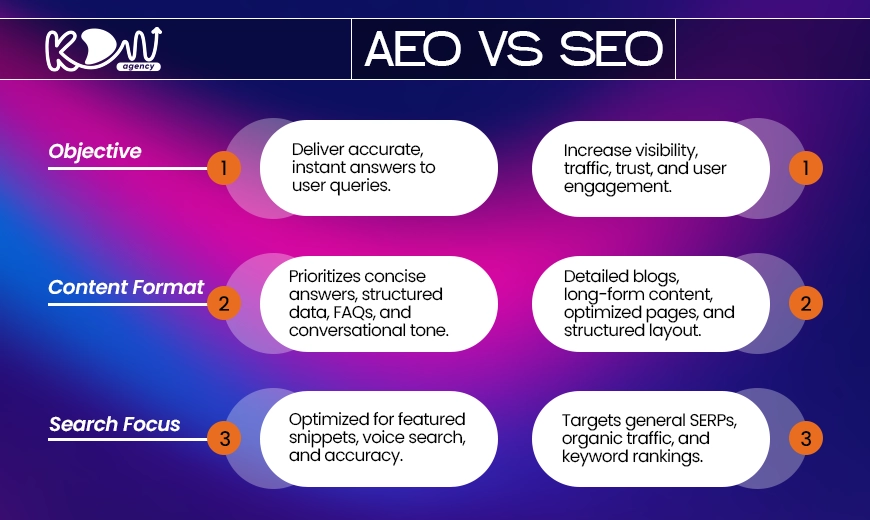
Focus: Keywords, backlinks, technical optimization.
Goal: Drive traffic to your website.
Challenge: Saturation. Everyone and their grandma is doing SEO.
Focus: Search intent, structured data, and direct answers.
Goal: Satisfy user queries instantly.
Challenge: Requires deeper understanding of audience needs.
Here’s the kicker: it’s not an either/or situation. SEO isn’t dead; it’s evolving. By integrating AEO into your strategy, you can hit two birds with one stone: attract traffic and provide answers.
To visualize this shift, we’ve created a chart showing the popularity trends of SEO and AEO over the years:
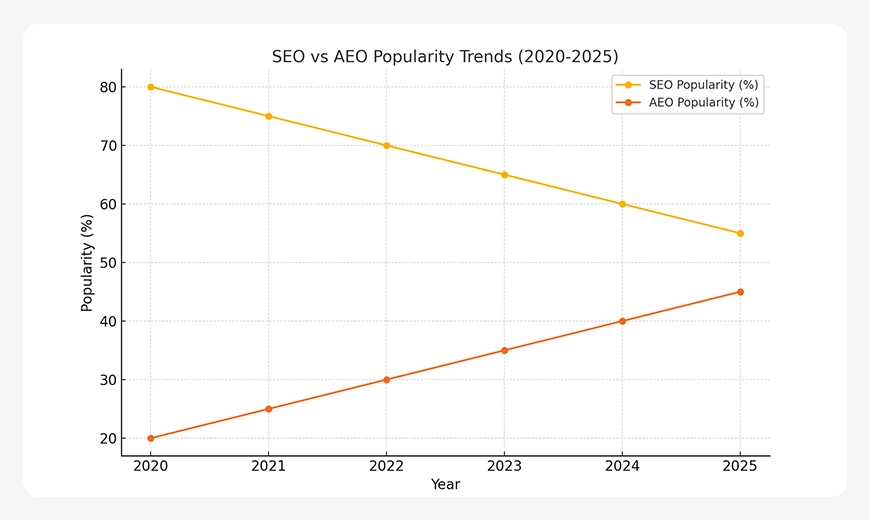
This chart clearly illustrates the gradual decline in SEO’s dominance, with its popularity dropping from 80% in 2020 to 55% in 2025. Conversely, AEO has risen steadily from 20% to 45% over the same period. This trend highlights how the industry is shifting towards a more intent-driven approach, making AEO an essential part of digital strategies.
Another aspect of understanding SEO’s evolution is recognizing which ranking factors matter most. Here’s a breakdown:
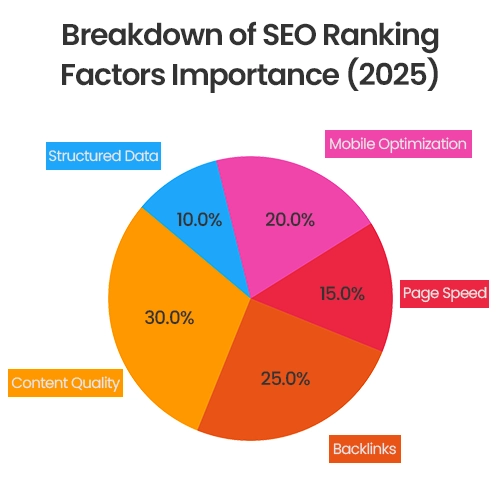
Content quality dominates the ranking factors in 2025, accounting for 30% of SEO importance. Backlinks remain vital at 25%, followed by page speed (15%), mobile optimization (20%), and structured data (10%). These insights reinforce the need for a holistic approach to SEO, where content and technical optimization go hand in hand.
Voice search is another game-changer. With devices like Alexa and Google Assistant becoming household staples, voice search has witnessed exponential growth:
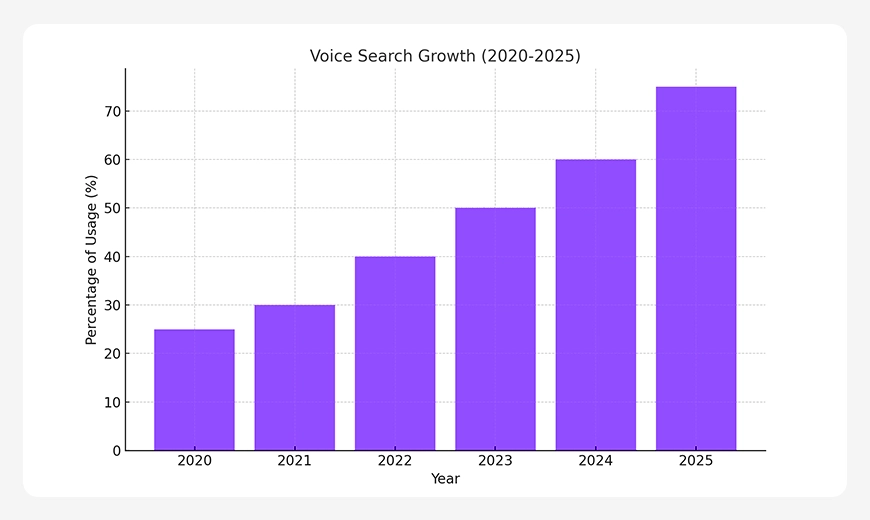
From 2020 to 2025, voice search usage has increased from 25% to a staggering 75%. This rise underscores the importance of optimizing content for conversational queries and long-tail keywords to capture voice search traffic effectively.
Search engines are no longer satisfied with showing a list of results. They want to provide answers directly on the search results page. Features like Google’s featured snippets, knowledge panels, and "People Also Ask" sections are prime examples of this shift. Users expect convenience, and AEO delivers it.
For instance, if someone searches for "best laptop for students," they don’t just want a list of laptops. They want to know why a particular laptop is best, what features it has, and even where to buy it. AEO helps your content meet these expectations.
Feeling a little overwhelmed? Don’t worry; you’re not the only one trying to navigate this shift. Here’s a detailed roadmap to help you master AEO and stay ahead:
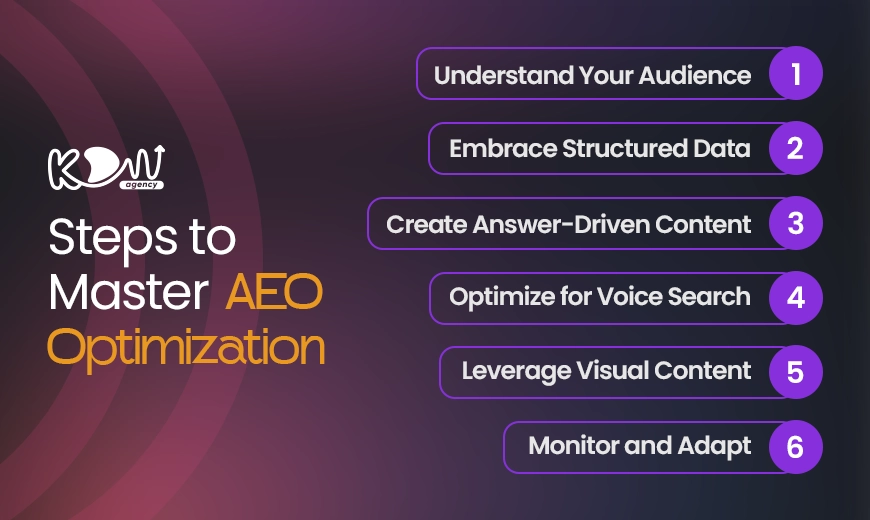
Use tools like Google Analytics and Search Console to analyze search intent and identify the exact questions your audience is asking.
Dive into forums like Quora or Reddit, and monitor platforms like Twitter or Facebook groups to understand trending queries in your niche.
Example: If you’re in the fitness industry, a common query could be, “What’s the best 10-minute workout for weight loss?”
Schema markup is your best friend. It tells search engines what your content means, not just what it says.
Implement FAQ schema for Q&A pages, product schema for e-commerce sites, and video schema for tutorials.
Bonus Tip: Structured data increases your chances of ranking for rich snippets, like review stars or recipe cards.
Prioritize FAQs, how-to guides, and listicles that address specific problems.
Example: Instead of a generic blog on "Digital Marketing," try "How to Create a Digital Marketing Strategy in 5 Steps."
Use bullet points, numbered lists, and subheadings to break content into bite-sized, scannable sections.
Focus on long-tail keywords and conversational phrases like “How can I improve my website traffic?”
Ensure your content reads naturally, as if answering someone directly.
Visuals like infographics, charts, and explainer videos enhance user engagement and make complex topics easier to grasp.
Example: For a blog on “Understanding AEO,” include a flowchart explaining how AEO works.
Regularly track AEO performance metrics like click-through rates (CTR) and snippet rankings using tools like SEMrush or Ahrefs.
Adjust your strategy based on what works. If a specific FAQ gets traction, create more content around similar topics.
By following these steps, you’ll not only boost your rankings but also provide value to your audience in a way that keeps them coming back.
Let us tell you about a brand that nailed this transition. Imagine a small e-commerce website selling eco-friendly products. Initially, they focused purely on SEO: keyword-rich blogs, backlinks, and on-page optimization. While they attracted traffic, conversions remained low.
Then came the AEO pivot. They added structured data, revamped their FAQ section, and optimized for voice search. Suddenly, their featured snippets skyrocketed, and they became a go-to source for queries like “How to reduce plastic waste?” Not only did traffic improve, but sales doubled. Coincidence? We think not.
Consider an online fitness training company. Initially, they relied heavily on SEO by targeting generic keywords like "best fitness trainer." While this approach brought traffic, it failed to convert effectively.
Once they adopted AEO principles, they focused on creating question-based content like "What is the best workout for beginners?" and optimized for voice search. Within months, they appeared in multiple featured snippets, boosting both credibility and client sign-ups.
Another example is a local bakery. By optimizing for "near me" searches and creating structured data for voice search results, they saw a 40% increase in walk-in customers.
Now think about a niche business like a specialized software provider. They redefined their strategy by answering highly specific queries, like "What CRM features are essential for small businesses?" By doing so, they captured an audience ready to purchase, not just browse.
Every few years, someone declares SEO dead. Yet, here we are, still talking about it in 2025. The truth is, SEO isn’t going anywhere. It’s evolving to meet new challenges and expectations. AEO is not a replacement but an extension of SEO. It’s about doing more with your content to stay relevant in an ever-changing digital world.
So, is SEO dead? Nope. But it’s definitely not the same SEO we knew a decade ago. Think of it as an evolving species. To stay ahead in 2025, you need to embrace AEO and adapt to the changing landscape.
The secret to success lies in understanding that SEO and AEO are two sides of the same coin. While SEO drives traffic, AEO ensures that traffic converts by answering user queries effectively. The sooner you align your strategy with this reality, the better.
Ready to future-proof your strategy? At Karachi Digital Marketing Agency, we specialize in blending SEO and AEO to help brands not just survive but thrive. Contact us to learn how we can transform your online presence.
A: Answer Engine Optimization focuses on optimizing content to provide direct answers to user queries, aligning with search engines’ shift towards solving problems.
A: Absolutely! While SEO has evolved, it remains critical for driving traffic. Combining SEO with AEO ensures maximum effectiveness.
A: Start by understanding search intent, using structured data, and creating concise, answer-driven content. Voice search optimization is also key.
A: AEO is particularly beneficial for e-commerce, healthcare, education, and technology sectors where users often search for specific answers to queries.
A: Small businesses can benefit by focusing on niche-specific queries, using local SEO combined with AEO tactics to attract targeted traffic.
A: FAQs are essential for AEO as they directly address user questions, improving content relevance and increasing chances of being featured in snippets.
A: Yes, AEO directly improves voice search rankings by focusing on natural language queries and delivering precise answers quickly.
A: Structured data and schema help search engines understand your content, making it easier for them to highlight your answers in snippets and knowledge panels.